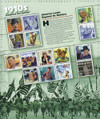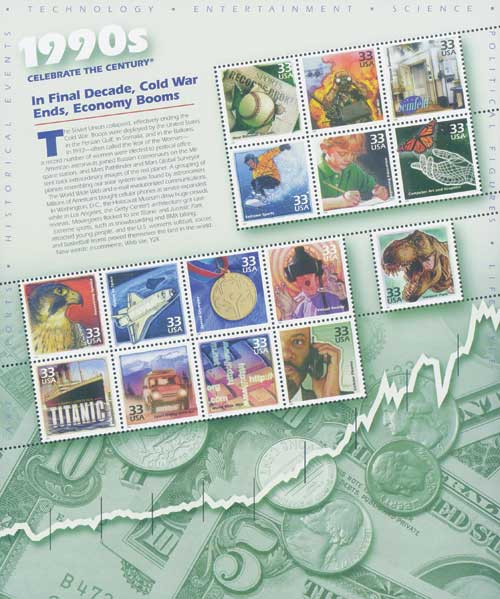
# 3183 - 1998 32c Celebrate the Century: 1910s
US #3183
1998 Celebrate the Century (1910s)
• The second sheet in the Celebrate the Century stamp series issued from 1998-2000
• Includes 15 stamps picturing important events from the 1910s
• Each stamp has text on the back detailing the event shown in the front design
Stamp Category: Commemorative
Series: Celebrate the Century
Value: 32¢ First Class Mail Rate
First Day of Issue: February 3, 1998
First Day City: Washington, DC
Quantity Issued: 188,000,000
Printed by: Ashton Potter (USA) Ltd.
Printing Method: Offset, Intaglio
Format: Panes of 15
Perforations: 11.6
Tagging: Bock Tagging
Why the stamps were issued: To commemorate important historical and cultural events from the 1910s that have a lasting legacy in the United States.
About the stamp designs: Pictures oil paintings by artist Dennis Lyall. The following topics were chosen for the 15 stamps on this sheet (and corresponding back markings of each):
Charlie Chaplin’s Little Tramp – “Charlie Chaplin first assumed his famous costume for the Little Tramp in 1914. The clothes, mustache, cane, and walk came to identify one of the most familiar icons in the history of film.”
Federal Reserve System 1913 – “The Federal Reserve System was created on December 23, 1913, to regulate banks and attempt to stabilize the nation’s monetary and financial system.”
George Washington Carver – “Botanist George Washington Carver improved the economy of the south by demonstrating the commercial possibilities of peanuts and sweet potatoes. His ‘Moveable School’ educated impoverished farmers.”
Armory Show 1913 – “The 1913 Armory Show introduced avant-garde art to this country. The highly controversial exhibition included Marcel Duchamp’s Nude Descending a Staircase, No. 2 that now hangs at the Philadelphia Museum of Art.”
Telephone Spans the Nation – “The first transcontinental telephone line was completed in 1914. On January 25, 1915, the first call was made by Alexander Graham Bell in New York to Thomas A. Watson in San Francisco.”
Panama Canal Opens 1914 – “The Panama Canal connects the Atlantic and Pacific Oceans, saving a ship traveling between New York and San Francisco almost 8,000 miles.”
Jim Thorpe, Star at Stockholm – “The first Native American sports hero, Jim Thorpe was hailed as the greatest athlete in the world after he won the pentathlon and decathlon in 1912 at Stockholm.”
Grand Canyon National Park 1919 – “The National Park Service was established by Congress in 1916. The Grand Canyon was officially designated a national park two and a half years later.”
US Enters World War I – “Two million American soldiers fought in Europe during World War I and more than 116,500 lost their lives. Back home, more than one million women joined the workforce.”
US Boy and Girl Scouting Begins – “The Boy Scouts of America was formed in 1910, and the Girl Scouts of the USA (at first known as Girl Guides) in 1912. Both groups introduce youth to a variety of outdoor activities and promote self-reliance and resourcefulness.”
President Woodrow Wilson – “President Woodrow Wilson was awarded the 1919 Nobel Peace Prize for his promotion of the League of Nations, the precursor to the United Nations.”
First Crossword Puzzle 1913 – “Newspaperman Arthur Wynne created the first crossword puzzle. It appeared in the New York World on Sunday, December 21, 1913. Clue 2-3: What bargain hunters enjoy.”
Jack Dempsey Wins Title 1919 – “Known as the Manassa Mauler because he was from Manassa, Colorado, Jack Dempsey won the world heavyweight boxing championship in 1919 and held it for seven years.”
Construction Toys – “Construction toys encourage children to build, create, and thing about how things work. Erector sets were introduced in 1913 and Tinkertoy in 1914, and Lincoln Logs in 1916.”
Child Labor Reform – “Child Labor Reform Lewis W. Hine’s photographs of children working in mines, mills, and factories led Congress to try to regulate child labor, but the Supreme Court declared early laws unconstitutional.”
First Day City: The First Day of Issue Ceremony was held in Washington, DC, with legendary radio and television host Larry King as master of ceremonies.
About the Celebrate the Century series: The USPS launched the Celebrate the Century series in 1998 to mark the end of the 20th century and herald the arrival of the 21st. The series includes 10 sheets of 15 stamps (150 in total), with each honoring important moments from a different decade (1900s, 10s, 20s, 30s, 40s, 50s, 60s, 70s, 80s, and 90s). At the time of completion, it was the longest and most ambitious commemorative stamp series in US history.
US #3183
1998 Celebrate the Century (1910s)
• The second sheet in the Celebrate the Century stamp series issued from 1998-2000
• Includes 15 stamps picturing important events from the 1910s
• Each stamp has text on the back detailing the event shown in the front design
Stamp Category: Commemorative
Series: Celebrate the Century
Value: 32¢ First Class Mail Rate
First Day of Issue: February 3, 1998
First Day City: Washington, DC
Quantity Issued: 188,000,000
Printed by: Ashton Potter (USA) Ltd.
Printing Method: Offset, Intaglio
Format: Panes of 15
Perforations: 11.6
Tagging: Bock Tagging
Why the stamps were issued: To commemorate important historical and cultural events from the 1910s that have a lasting legacy in the United States.
About the stamp designs: Pictures oil paintings by artist Dennis Lyall. The following topics were chosen for the 15 stamps on this sheet (and corresponding back markings of each):
Charlie Chaplin’s Little Tramp – “Charlie Chaplin first assumed his famous costume for the Little Tramp in 1914. The clothes, mustache, cane, and walk came to identify one of the most familiar icons in the history of film.”
Federal Reserve System 1913 – “The Federal Reserve System was created on December 23, 1913, to regulate banks and attempt to stabilize the nation’s monetary and financial system.”
George Washington Carver – “Botanist George Washington Carver improved the economy of the south by demonstrating the commercial possibilities of peanuts and sweet potatoes. His ‘Moveable School’ educated impoverished farmers.”
Armory Show 1913 – “The 1913 Armory Show introduced avant-garde art to this country. The highly controversial exhibition included Marcel Duchamp’s Nude Descending a Staircase, No. 2 that now hangs at the Philadelphia Museum of Art.”
Telephone Spans the Nation – “The first transcontinental telephone line was completed in 1914. On January 25, 1915, the first call was made by Alexander Graham Bell in New York to Thomas A. Watson in San Francisco.”
Panama Canal Opens 1914 – “The Panama Canal connects the Atlantic and Pacific Oceans, saving a ship traveling between New York and San Francisco almost 8,000 miles.”
Jim Thorpe, Star at Stockholm – “The first Native American sports hero, Jim Thorpe was hailed as the greatest athlete in the world after he won the pentathlon and decathlon in 1912 at Stockholm.”
Grand Canyon National Park 1919 – “The National Park Service was established by Congress in 1916. The Grand Canyon was officially designated a national park two and a half years later.”
US Enters World War I – “Two million American soldiers fought in Europe during World War I and more than 116,500 lost their lives. Back home, more than one million women joined the workforce.”
US Boy and Girl Scouting Begins – “The Boy Scouts of America was formed in 1910, and the Girl Scouts of the USA (at first known as Girl Guides) in 1912. Both groups introduce youth to a variety of outdoor activities and promote self-reliance and resourcefulness.”
President Woodrow Wilson – “President Woodrow Wilson was awarded the 1919 Nobel Peace Prize for his promotion of the League of Nations, the precursor to the United Nations.”
First Crossword Puzzle 1913 – “Newspaperman Arthur Wynne created the first crossword puzzle. It appeared in the New York World on Sunday, December 21, 1913. Clue 2-3: What bargain hunters enjoy.”
Jack Dempsey Wins Title 1919 – “Known as the Manassa Mauler because he was from Manassa, Colorado, Jack Dempsey won the world heavyweight boxing championship in 1919 and held it for seven years.”
Construction Toys – “Construction toys encourage children to build, create, and thing about how things work. Erector sets were introduced in 1913 and Tinkertoy in 1914, and Lincoln Logs in 1916.”
Child Labor Reform – “Child Labor Reform Lewis W. Hine’s photographs of children working in mines, mills, and factories led Congress to try to regulate child labor, but the Supreme Court declared early laws unconstitutional.”
First Day City: The First Day of Issue Ceremony was held in Washington, DC, with legendary radio and television host Larry King as master of ceremonies.
About the Celebrate the Century series: The USPS launched the Celebrate the Century series in 1998 to mark the end of the 20th century and herald the arrival of the 21st. The series includes 10 sheets of 15 stamps (150 in total), with each honoring important moments from a different decade (1900s, 10s, 20s, 30s, 40s, 50s, 60s, 70s, 80s, and 90s). At the time of completion, it was the longest and most ambitious commemorative stamp series in US history.














